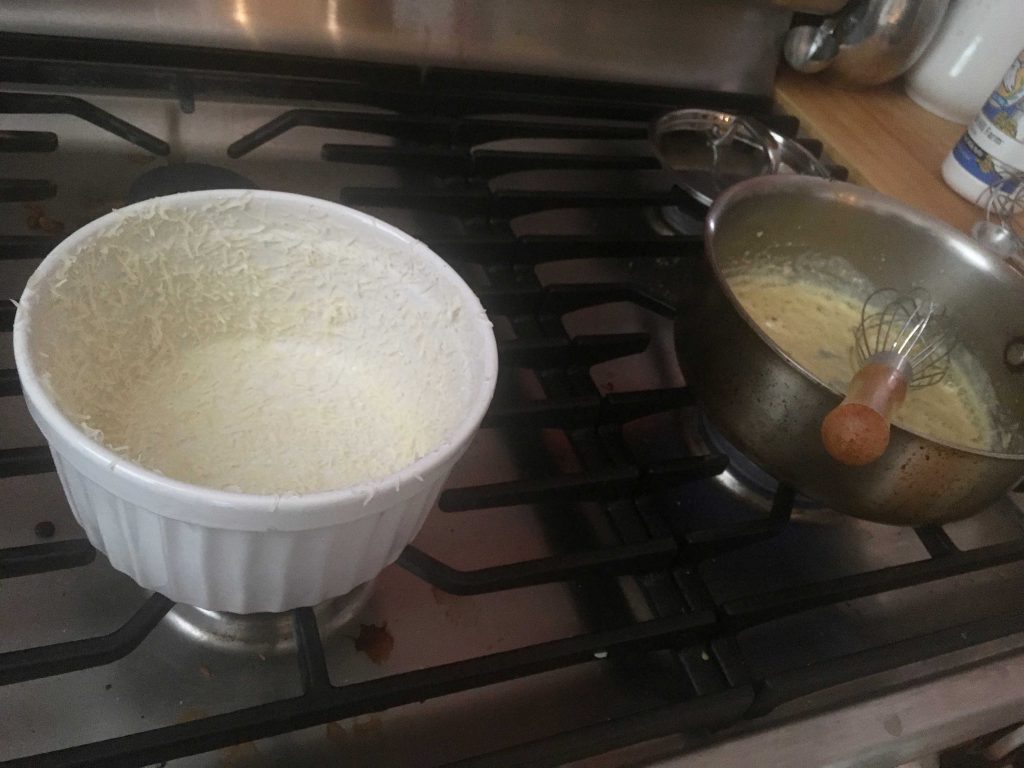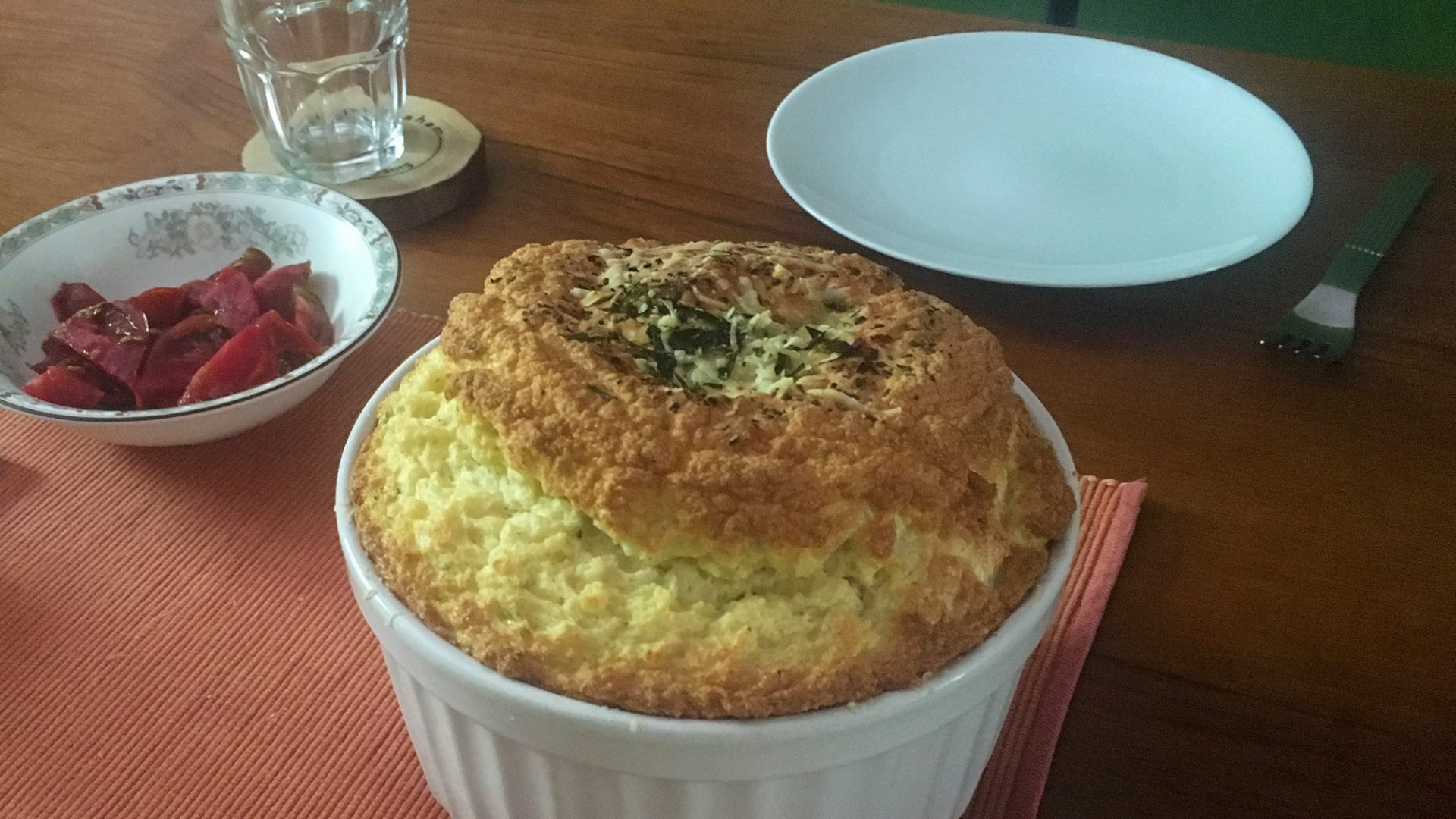Soufflé is deceptively simple to make. First, get some basic cooking skills, then make a velouté, add beaten yolks, add grated cheese, pour into stiffly-beaten egg whites, mix gently and pour into a prepared soufflé dish. Bake, eat immediately.

If you have the general process in your brain, you can then design and create a more interesting soufflé, or always have it at the ready to make a quick (impressive) meal. The step-by-step process is be to preheat an oven to 400 degrees F, grease a soufflé dish and dust it, usually with finely grated Parmesan cheese. Get the ingredients together now, and you’ll probably have the batter finished by the time the oven reaches temperature.
Make a velouté sauce – meaning melt butter, stir in the flour and let this ‘roux’ cook until it looks smooth and starts to thicken, and while you occasionally stir this with a wooden spoon, separate the eggs, and beat the yolks and whites separately. You’re going to add enough liquid to make the sauce something you’d like to pour over a chicken breast or asparagus. It should be cake-batter consistency, but what you use as the liquid can vary. Use your imagination.
Your soufflé’s flavor theme can begin with something you have on hand, and with the liquid you choose can, the cheese (or no cheese) or the intersections of these. This is the fun part, and is more fun if you do it before you start cooking. The most popular recipe is cheese (Gruyère and/or Parmesan) and for this classic soufflé you might want to exchange the velouté for a béchamel – similar sauces that start with a roux, but the first leaves open what liquid to add (stock, wine, etc) and the other, the white or béchamel, adds simply milk. You can add salt and pepper and whatever other spice you want to this sauce.
To expand on classic, use your taste imagination to come up with flavors that taste great together. First, imagine a fluffy egg omelet. What doesn’t go with that? Cheese is classic but not necessary – what’s in the frig that would love grating? Blends of the last of a couple could be great. To be sure smell them together, and remember what the cheese tasted like – it’s a remnant in your frig so you probably did eat it. If you come up nil in taste memory, you can taste a small bit now. In the finished soufflé cheese is very much the general atmosphere but isn’t overwhelming at the proportions in most recipes. Smell your combination while you grate to help decide what else to add. Grating a cup of cheese is the most time consuming part of soufflé making, so this can be done before you turn on the oven. Think of herbs you have in the garden that go with this smell, or spices in your rack or pantry. If you have a half serving of a vegetable left over from a previous meal here’s a place to use it. When all these influences are put together, mentally smell those, and choose your liquid: milk, cream, buttermilk, left-over stock, or a wine or liquor that will go with what you’ve already chosen.
I like to have the cheese grated and these herb and add-ons decided upon and ready before I start cooking the roux. If you have a helper, maybe a friend who has showed up unexpectedly and is the reason you decided to whip up a soufflé, this helper can grate cheese and chop herbs. The only technical pressure you should feel while making a soufflé is the minute where you add the egg yolks, then mix the sauce into the whites, and pour all into the dish that you slide into the middle of a hot oven. Then relax, talk, open a bottle of French burgundy, set the table and be ready to eat as soon as it comes out of the oven 40 minutes later.
This technical moment should be done quickly, yes, but with a slow mind. Sauce shouldn’t be too hot, but if it is, add a little to the yolks stirring immediately and until you bring them to the whole sauce, and stir until they are an even consistency. You want to know you sauce is smooth, so unless it will really enhance flavor, I’d add the extras at this point at the soonest. But I’d break this rule for a vanilla bean, and I can recognize it even in a sauce. There is no rush to get to the next step – incorporating the beaten whites but when you do, the warm sauce should go in very slowly and you should fold together gently to deflate the whites as little as possible. If you need to time – meal will start in an hour instead of 40 minutes, buy it here, but do run the whisk through the whites one more time before you add the sauce just to reinflate anything that has drop to the bottom of the bowl. I use a whisk because it’s much easier than getting out something mechanical and I need the arm exercise. I’ve practiced enough that I can whisk left and right handed, and that’s useful. I’ve invested is a couple of great whisks and with them I can do 4-6 whites in less time than grating a cup of cheese. You can, too.
You can turn the oven down to 375°F, and that will buy a little more time. Or keep it at 400 if you want to serve in 30 minutes. You can let the batter rest in the dish for a short amount of time if it doesn’t move or suffer temperature change, but this isn’t a great substitute for good planning. Make this a few times, and you’ll find you have the muscle memory to be do it easily, and if you record the time and temperature – on the page with your basic recipe, you won’t have to sweat about it when you start the next one and you just back out from the time you want to serve, the cooking time plus 5 minutes. That’s when you start to cook. Before that you can do the tasting and imagining that will make this soufflé really creative. And that can sit for all long as you want.
Below is the detailed recipe I used today with what I had in the refrigerator. Imagine eggs and tarragon, Parmesan and pepper. Garden fresh tomato. Hopefully, you’ll find an occasion to taste it soon.
Ingredients
Spray duck fat
Parmesan cheese, very finely grated for the soufflé mold
3 tablespoons (25 grams) flour
3 tablespoons (42 grams) butter
1 teaspoon mix of Aleppo pepper, curry and salt, and a grate of nutmeg
1/2 cup of kefir, 1/2 cup of water, 2 Tablespoons of tarragon vodka
4 large eggs
1/2 cup Parmesan cheese
1 quart (1 liter) oven-safe bowl or soufflé dish
2 T of Parmesan and 1 T of fresh tarragon chopped for the top.
Melt butter in a saucepan, add flour and stir until smooth, let cook a minute while you separate the eggs. Put whites in a large bowl so you can whisk until they triple their volume and form stiff peaks. I beat the yolks a little, and wash my fabulous whisk. Then I add the keffir, vodka and a little water. I kept the glass by the stove to use to get the right consistency for this sauce.
I grate cheese and cut some tarragon. While I’m doing the grating, and the whisking of eggs, I give the sauce a stir. Its consistence should be sauce-like, a Hollandaise-y one, and it should cook so the flour doesn’t taste raw. This cooking give you the time to do the other tasks. I add ground black pepper to the grated cheese and the other spices to the sauce.
When cheese, whites, sauce and yolks are ready, I do the one hard move: add the yolks slowly to the not-too-hot sauce, stir to incorporate and pour this mixture into the beaten egg whites, slowly and stirring gently. Add the cheese, herb. Gently mix just until whites are no longer visible and pour into the prepared dish. Sprinkle with a reserved tablespoon or so of cheese and tarragon. Set in the middle of the oven and set timer to 40 minutes. Turn oven down to 375°F. Set table. Open some white Burgundy wine. And I chop a fresh tomato. A little bread and butter and radishes make it perfect.
This served two as a lunch, but would have easily served 4 as a first course.
